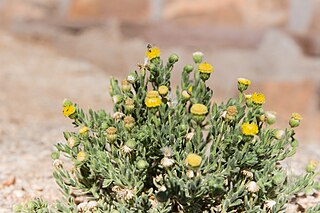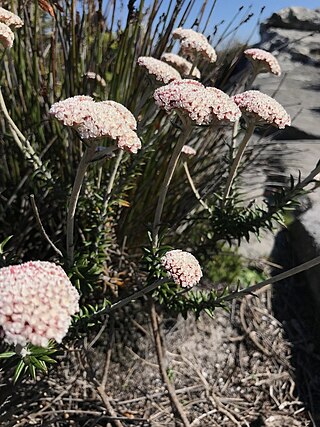
Felicia echinata, commonly known as the dune daisy or prickly felicia, is a species of shrub native to South Africa belonging to the daisy family. It grows to 1 m (3.3 ft) high and bears blue-purple flower heads with yellow central discs. In the wild, it flowers April to October.

Felicia namaquana is a glandular-hairy, branching annual plant of up to 25 cm (10 in) high that is assigned to the family Asteraceae. It is sometimes called Bloublommetjie or pers poublom in Afrikaans. Flowering occurs between May and October. It grows in Namibia and South Africa.

Felicia nordenstamii is a flowering shrub in the family Asteraceae. It is found only in South Africa where it grows on limestone hills close to the sea on the southern coast. Felicia nordenstamii is a many-branched shrub growing up to 30 cm (1 ft) tall. The lower parts of the stems are covered in grayish brown bark and the upper stem has many crowded, upwardly angled, alternate leaves with long hairs on the lower surfaces. Large flower heads form at the tips of the branches, each about 41⁄2 cm across, with about thirty purplish blue ray florets surrounding many yellow disc florets.
Felicia clavipilosa is an upright, richly branched shrub of up to 60 cm (2 ft) high, that is assigned to the family Asteraceae. It has alternately arranged leaves, and flower heads with 3–4 whorls of involucral bracts with many yellow disc florets in the centre. Very characteristic for the species are the short club-shaped hairs on its fruits. There are two subspecies. Subsp. clavipilosa has narrowly lance-shaped entire leaves with one vein and pale mauve ray florets. Subspecies transvaalensis has lance-shaped leaves with one or three veins and white ray florets. The species occurs in southern Africa, with subsp. clavipilosa having a western distribution in Zambia, Zimbabwe, Namibia, Botswana and South Africa, and subsp. transvaalensis restricted to the east, from Zimbabwe, through Botswana to South Africa. The subspecies transvaalensis is sometimes called pokkiesblom in Afrikaans.
Felicia cana is a low and slender shrublet of up to 15 cm high, covered in white felty hairs, that is assigned to the family Asteraceae. It has alternately arranged leaves, and flower heads of about 16 mm (0.63 in) across, with 3–4 whorls of involucral bracts, and about 20 blue purple ray florets, surrounding many yellow disc florets in the centre. Very characteristic for the species are also the middle-long hairs with forked tips on the surface of its fruits. It is an endemic species that is restricted to a zone along the southern coast of the Western Cape province of South Africa.

Felicia is a genus of small shrubs, perennial or annual herbaceous plants, with 85 known species, that is assigned to the daisy family. Like in almost all Asteraceae, the individual flowers are 5-merous, small and clustered in typical heads, and which are surrounded by an involucre of, in this case between two and four whorls of, bracts. In Felicia, the centre of the head is taken by yellow, seldom whitish or blackish blue disc florets, and is almost always surrounded by one single whorl of mostly purple, sometimes blue, pink, white or yellow ligulate florets and rarely ligulate florets are absent. These florets sit on a common base and are not individually subtended by a bract. Most species occur in the Cape Floristic Region, which is most probably the area where the genus originates and had most of its development. Some species can be found in the eastern half of Africa up to Sudan and the south-western Arabian peninsula, while on the west coast species can be found from the Cape to Angola and one species having outposts on the Cameroon-Nigeria border and central Nigeria. Some species of Felicia are cultivated as ornamentals and several hybrids have been developed for that purpose.
Juncus capillaceus is a rush species native to South America, but has been introduced to other parts of the world.
Euryops ursinoides is a highly endemic and vulnerable species from South Africa. It is in the daisy family.
Senecio ruwenzoriensis is an African species of plant. While it is widely distributed, it seems to be highly localised in this range.

Senecio malacitanus, also known as Senecio linifolius is a species of plant from South Africa.
Printzia pyrifolia is a species of plant from South Africa.

Athanasia quinquedentata, or the fivetooth kanniedood, is a species of plant from South Africa.

Nolletia gariepina, the desert beesbossie, is a species of plant from southern Africa.

Helichrysum retortum, the flask everlasting or sea strawflower, is a species of plant from South Africa.
Helichrysum sphaeroideum is a species of plant from South Africa.
Athanasia grandiceps is a species of plant from South Africa. It belongs to the daisy family.
Osmitopsis parvifolia is a species of plant from South Africa.

Anaxeton arborescens, the northern paperposy, is a species of plant from South Africa. It grows in the fynbos biome.
Osteospermum burttianum is a species of plant from South Africa.
Amphiglossa corrudifolia is a species of plant from South Africa.








